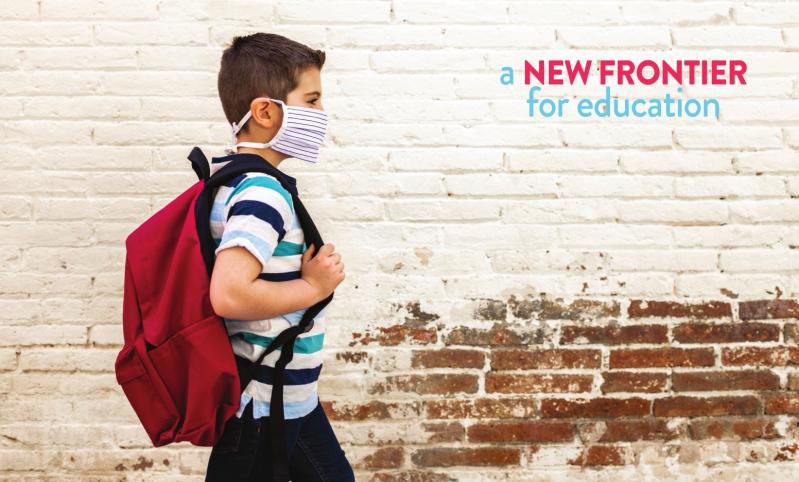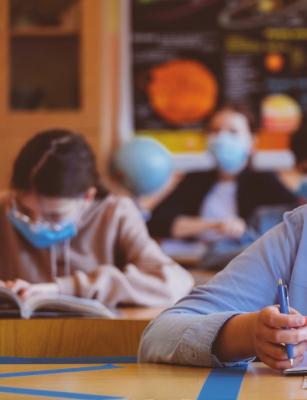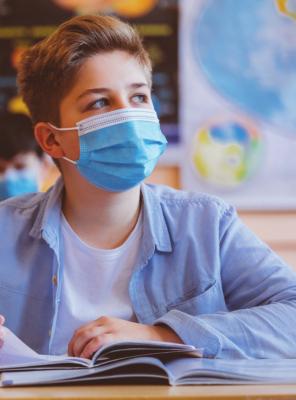
Education is about more than textbooks, chalk boards and classrooms. Students, teachers and administrators all learned that lesson under the stay-athome order issued by Gov. John Bel Edwards to mitigate that COVID-19 pandemic. The order closed school buildings and shifted learning online to close out the 2019-20 school year.
With the 2020-21 school year on the horizon, administrators for local schools at all levels are planning for the best and preparing for the worst.
The Louisiana Department of Education released its guidance on how school systems across the state can reopen for the 2020- 2021 school year on June 25. Those guidelines used the latest medical information available and outlined precautions that must be in place to reduce the spread of COVID-19. They were created in conjunction with the Louisiana Department of Health and the Resilient Louisiana Commission.
Additionally, the standards were developed with input from public health officials, education leaders and other key stakeholders. That collaboration includes consultation with the Southern Regional Education Board, a superintendent's advisory group of 13 district leaders from across the state, and a 20-member public health response team of medical professionals, public health officials and education leaders.
The guidelines serve as minimum standards while giving school districts the flexibility to decide how local schools will operate. Districts are encouraged to prepare for three possible reopening scenarios: traditional, hybrid or virtual instruction, like the procedures that were introduced during the stay-at-home order.
Strong Start 2020: Guidelines and Resources for School Reopening is available now on the LDOE website, www. louisianabelieves.com, and includes a number of guidelines and best practices for districts including the following:
• Bus capacity and student group size
• Student symptom monitoring
• Face coverings
• Food prep and meal service
Caddo and Bossier schools both will follow the state guidelines.
Sonja Bailes, public relations liaison for Bossier Schools, said officials were moving forward with plans to open the school year under Phase 2 guidelines.
“We recognize child care is a real concern among many parents with younger students, and while it will be a challenge, Bossier Schools is working within state guidelines to provide daily face-to-face instruction for PreK-5th grades in Phase 2,” Bailes said. “Our principals have looked at every procedure, transition and scenario at their schools and we feel this can be achieved through static grouping, social distancing, altering breakfast/lunch schedules and staggering class rotations to the maximum extent possible.”
Keith Burton, chief academic officer for Caddo Schools, said the district faces a challenge in providing a safe environment and the best atmosphere for learning.
“As
far as Caddo is concerned, we all are looking at the guidelines and
ensuring that there is consistency,” Burton said. “Student and staff
health is paramount. Beyond that, what can we do to ensure the best
instructional model?” Burton said the latest guidelines on education
show that a face-to-face model works better for elementary and middle
school students than a virtual learning platform. He hopes to open the
school year with a “semi-traditional” model that resembles a traditional
learning environment as closely as possible.
“Virtual
learning doesn’t necessarily work with very young children,” he said.
“It creates a burden for daycare and juggling the safety factors. We are
working as hard as we can to have it happen with as close to a
traditional start as possible.”
Bossier schools will adopt a hybrid schedule for grades 6 through 12, Bailes said.
“An
A/B schedule will be implemented for grades 6-12 if the state remains
in Phase 2,” she said. “Students will be divided into groups that will
receive face-to-face instruction one day and virtual learning at home
the next. Once Louisiana enters Phase 3, all students will return to
school for daily face-to-face instruction. For parents uncomfortable
sending their children back to the classroom environment at this time,
remote learning options will be offered at all grade levels.”
Burton
said high school students cannot remain in static groups in the way
that elementary and middle school students can. For that reason, the
high schools plan to implement a hybrid model, with some students
participating in the classroom and some participating virtually. Older
students are “much more adaptive” to virtual learning, Burton said.
Burton
said teachers, faculty and students all learned much in the past nine
weeks of last school year. The district is putting those lessons to use
in preparing for this school year.
“We
made transition in just a few days,” he said. “It was a triage
approach. We have adopted a new learning platform called Canvas. It will
help with organization and engagement of instruction. With it, we can
support teachers and have a pulse on what students are doing and who is
and is not engaged.
“We
also learned about flexible online learning. Some learn better live, in
face-to-face settings. But we also can offer lots of on-demand
learning. Because some students would love to be able to choose when
they learn. That’s one of the other lessons that we learned.”
Bailes
said Bossier Schools addressed issues about accessibility and teacher
training during the summer to prepare for the possibility of more remote
learning.
“Internet
connectivity was a big problem, and we were able to identify those areas
of the community with weak or non-existent connectivity and secure
hotspots to strengthen the signal in those areas,” she said. “Hundreds
of teachers have also received professional development on Google
Classroom over the summer to be better prepared for future virtual
instruction needs. Given the evolving nature of the coronavirus, Bossier
Schools will be in a better position for remote delivery no matter what
phase we may be in throughout the year.”
Caddo
Schools will make an official announcement soon on how schools will
reopen. Burton reminds parents that, regardless of how school opens,
parents have a choice in educating their children.
“Parents
always have an option,” he said. “They have to place their child’s
health and safety as the most important decision. Regardless of model,
parents have the chance to chose a virtual model. If I have a
third-grader and am concerned about him coming to school, my school will
offer a virtual model for my child. We can stay connected to the
principal and teachers and students.
“It’s
not a year-long choice, either. “After nine weeks, if the (coronavirus)
rates are down and a possible vaccine is around the corner, they will
have the opportunity to make the transition. Families do have a choice.”
As
principal at Magnolia Charter School, Mary Nash Robinson is preparing
for her 46th opening of a school year. This one will be unprecedented,
she said.
“We’ve been
talking about transformation of our school for forever and a day,”
Robinson said. “The last nine weeks of last year and the opening of this
year, this is truly transitional. Never have we done it like this.”
Robinson
said that, like Caddo and Bossier schools, Magnolia is following the
guidelines form the CDC and the state for reopening. Magnolia had an
enrollment of 460 students last year and a capacity for about 1,200.
Under Phase 2 or Phase 3 guidelines, Robinson plans to welcome all of
Magnolia’s students back to campus at the start of the school year. She
said officials from Charter Schools of America, which oversees the free,
public charter school, came recently to measure the buildings on campus
and confirm the school’s potential capacity.
Robinson
is eager to see students return to campus. “I am hoping the situation
allows me to invite our students back,” she said. “People have to go to
work. What do you do with young people? They need to be in school. They
need that contact and the physical interaction with their teachers.”
The
faculty and staff at Magnolia learned a great deal while under the
stay-at-home order, Robinson said. They learned about a variety of
resources to reach students through different modalities, and they were
able to find a platform, a program or an app to to guide them through
any circumstance. That, Robinson said, was a benefit to the staff
regardless of the circumstances moving forward.
“Our
learning curves were reduced really quickly,” she said. “It wasn’t as
hard as we thought it was. Even the more traditional teachers came on
board. We can now do things much differently that we were accustomed
to.”
Robinson said she
is eager and optimistic to welcome students back on campus. But the
safety of the students and the faculty is a top priority, and Magnolia
will take all precautions to protect that should the guidelines change.
“We’re
making plans to make more devices available, to make internet access
available, to help parents become more familiar and comfortable,” she
said. “We are looking into what’s called the mobile classroom, If we
have to do that, we will be prepared to do that.”
Online
learning is not a new concept for local universities. Louisiana State
University Shreveport, for example, has long offered online learning and
will continue to leverage those resources for student. LSUS also has
been adapting its classrooms to prepare for the upcoming semester,
regardless of what phase of recovery the state is in at that point.
“For our face-to-face classes we are preparing and
adapting classroom and instructional spaces, and we expect to be able
to offer those classes in person in the fall semester,” said Dr. Helen
Clare Taylor, provost and vice chancellor of academic affairs. “We have a
team measuring off appropriate distances and putting up signage in
classrooms, hallways and staircases. We are also equipping classrooms
with enhanced technology to make us as flexible as possible and to give
our students and faculty optimum safety combined with optimum
instructional quality.”
Taylor
said that if the state moves back to Phase 1 and another stay-at-home
order is issued, LSUS will be prepared to switch to all-online learning
again.
“We are also
prepared to offer these classes online should the virus numbers mandate
another pivot to remote teaching,” she said. “We are offering additional
training to our faculty so that they can provide the best instructional
experience for our students.”
Taylor
said the faculty at LSUS found “the silver lining” in the previous
stay-at-home order. The faculty learned a variety of new teaching
techniques and implemented new technologies into their practices.
“I
think many of us found that we actually enhanced our teaching through
these modes of delivery and that we will continue to adopt them,” she
said. “Our students can look forward to a richer classroom experience
because our incredible and hardworking faculty always put instructional
quality and the benefit of students first.”
Taylor said LSU is eager to provide students the best educational experience available, regardless of the circumstances.
“We
understand that things will return to some level of normality at some
point, and we have to always keep our focus on making sure that our
students are on even footing when that time comes,” Taylor said. “This
still takes hard work, and we are all committed to that effort.”
Southern
University of Shreveport is prepared to open the fall semester under
its Phase 2 guidelines, which were created in partnership with Ochsner
LSU Health Shreveport. Those guidelines include screenings for everyone
entering the campus, increased sanitation in all common areas on campus,
including restrooms, and physical distancing measures in classrooms and
laboratories.
“When
we partnered with Ochsner, they came and did a walkthrough and gave us a
proposal for keeping the campus safe,” said Dr. Tony Pegues, vice
chancellor for finance and administration. “We are providing a safe
environment by limiting the number of people who can gather in any given
place. There is a minimum number of people allowed for each room posted
outside each door.
“For
our labs and classrooms, we have physical distancing in place. We have
removed chairs in classrooms to increase the physical distance between
students. In our labs, we have the ability to turn off every other
computer to create that physical space.”
Pegues
said online learning would be available to students in the fall. And
some hybrid classes, with in-class and online learning options, that
began with the COVID-19 pandemic will continue in the fall as well.
The
university is grateful for its community partners during the pandemic
and looks forward to continuing its role in the community.
“We
appreciate being a part of this community,” Pegues said. “During the
pandemic, we appreciate the partnerships we have around the community.
Southern University is a safe and healthy environment for student to
continue their academic endeavors. We look forward to being a healthy
part of the solution during this time.”
SUSLA
has about 3,000 students, Pegues said, with approximately 2,000 on
campus any given day during a regular semester. Pegues said all the
measure that have been put in place serve to eliminate the worst-case
scenario: a COVID-19 outbreak on campus.
“We
have a plan in place for that,” he said. “We will usher students or
anyone with symptoms to quarantine rooms, where they can virtually speak
with staff from Oschner and get transported to Oschner for further
observation.”
Taylor agreed that preparing for the worst is essential.
“We
know that there is a risk of the virus affecting our campus in the
fall,” Taylor said. “The worst-case scenario for us would be if we are
not prepared to adapt and adjust, with the safety of our students,
faculty and staff as our top priority. However, we have remained
steadfast in our preparation for the unknown, as difficult as that can
be. I am confident that LSUS will be ready to meet the future because of
the hard work and planning of every member of our campus community.”

